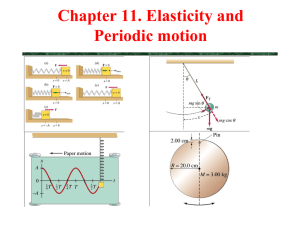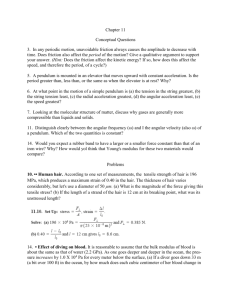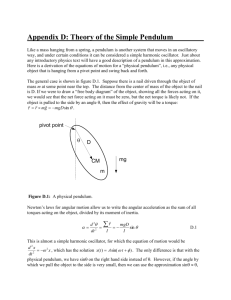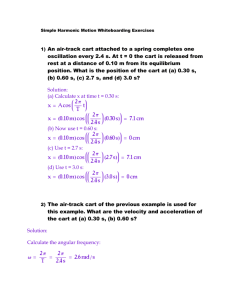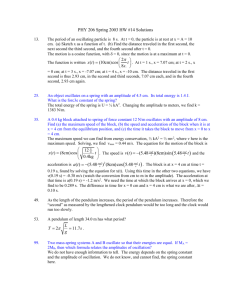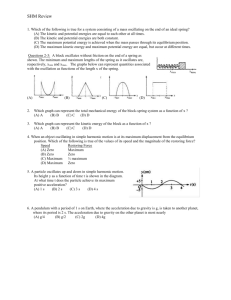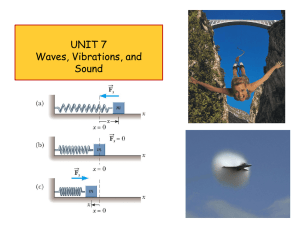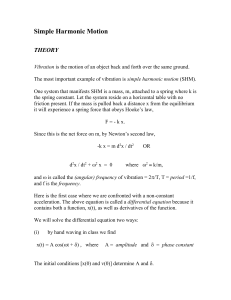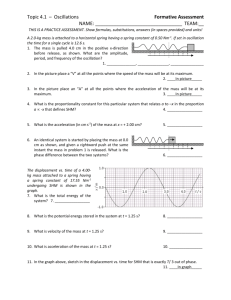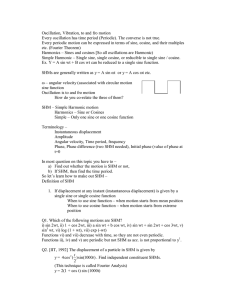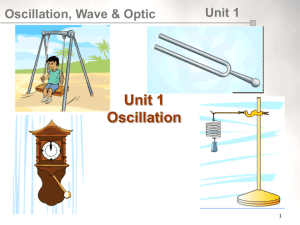ω ? θ
advertisement
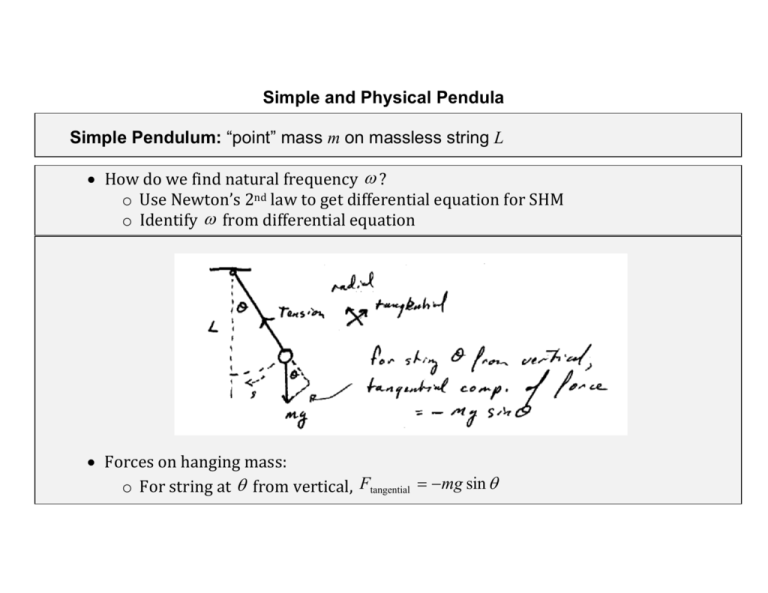
Simple and Physical Pendula Simple Pendulum: “point” mass m on massless string L Howdowefindnaturalfrequency ? o UseNewton’s2ndlawtogetdifferentialequationforSHM o Identify fromdifferentialequation Forcesonhangingmass: o Forstringat fromvertical, Ftangential mg sin Tangentialacceleration: o Reminder:forpointatdistanceRfromcentreofbodywithangular d 2 acceleration dt 2 ,tangentialaccelerationis a tangential R o SoformassonstringoflengthL,tangentialaccelerationis atangential (Remember: mustbeinradianshere) Newton’s2ndLaw: Ftangential d 2 matangential gives mg sin mL 2 dt d 2 g sin o Result: dt 2 L o NotquiteSHMBUTforsmallangle, sin (for inradians) d 2 L 2 dt d 2 g SimplePendulumresult:forsmall ,have dt 2 L g 2 o LookslikeSHMwith L Note,doesnotdependonm! StrictlySHMforsmallangleonly.Slightlydifferentfromsinusoidal forlargeramplitude. 2 L T 2 o Periodis g o Solutionis max cos t Canseeswingingmotionforobjectsthatare muchmorecomplicatedthanamassona string. o Needmoregeneralresult! Physical Pendulum: NOTa“point”massonamasslessstring.Lookatrotationofrigidbody. Newton’s2ndlawforrigidrotatingobjectwithmomentofinertiaIis I o Restoringtorqueduetogravityatcofm distancedfrompivotis: mgd sin d clockwiseforpositive d 2 o Angularaccelerationis dt 2 Canrewrite I asdifferentialequation: d 2 mgd sin (notquiteSHM) o dt 2 I Forsmallangle, sin ,get d 2 mgd o dt 2 I mgd 2 o SHMwith I Small angle result for Physical Pendulum with moment of inertia I mgd SHMwithangularfrequency I I 2 T 2 Periodis mgd AngularfrequencyandperioddependonshapeofswingingobjectANDon locationofpivot(boththroughIandd) o Because I m ,masscancelsoutand doesnotdependonm Checkforsimplependulum 2 o Forsimplependulum, I mL and d L mgd g 2 asexpectedforsimplependulum So I L Example: Physical Pendulum consisting of a suspended from one end Mass=M,Length=L 1 I ML2 Momentofinertia: 3 L d Distancefrompivottocofm: 2 mgd MgL / 2 3g Soangularfrequencyis I ML2 / 3 2 L o Independentofmass rod DAMPED OSCILLATION: Objectmovingthroughfluid(likeair)feelsspeed‐dependentresistiveforce: o Dampingforce: R bv (non‐conservative.Dissipatesmech.energy) Formassmonspringkmovingthroughfluidwithcoefficientb o Newton’s2ndLaw: Fx kx bv x ma x d 2x b dx k x o Givesdifferentialequation: dt 2 m dt m k Definenaturalfrequency 0 m o FrequencyofoscillatorinABSENCEofdamping b Solutiontodifferentialequationdependsonrelativesizeof 0 and 2m o i.e.comparisonofnaturalfrequencyandamountofdamping b UNDERDAMPED MOTION: small b so that 0 2m or b 2m 0 Systemdoesnotoscillateatnaturalfrequency: 2 b o Shiftedto m 2 o Besuretodistinguish and 0 2 0 2m Amplitudeofoscillationdecaysexponentiallywithtimeconstant b bt / 2 m cos t Completesolutionis: x Ae CRITICALLY DAMPED MOTION: see for b bc 2m 0 Systemreturnstoequilibrium exponentiallywithnooscillation b OVERDAMPED MOTION: large b so that 0 2m Systemreturnstoequilibriumwithno oscillationandmoreslowlythancritical case (See Dan Russell animations: link on web page) or b 2m0 FORCED OSCILLATIONS AND RESONANCE Dampedoscillatorcanbekeptatconstantamplitudebyaddingenergythrough periodicforce–forcedoscillation o Amplitudedependsonfrequency Example:Applyperiodicforce F t F0 sin t tomassmonspringkmoving throughfluidwithcoefficientb o Careful:Besuretodistinguish and 0 dx d 2x o Newton’s2ndLawgives: F0 sin t b dt kx m dt 2 o Ifdrivingforceisappliedtosysteminitiallyatrest,initialmotionis complicatedbuteventuallysettlesintosteadystatesolution o Aftersystem“settlesdown”,getsteadystatesolution: x A cos t oscillateswithfrequency ,not 0 Amplitudedependsondrivingfrequencyanddrivingforce F0 / m A 2 2 02 b / 2m 2 maximumamplitudeat resonance, 0 o amplitudeatresonance dependsonb
